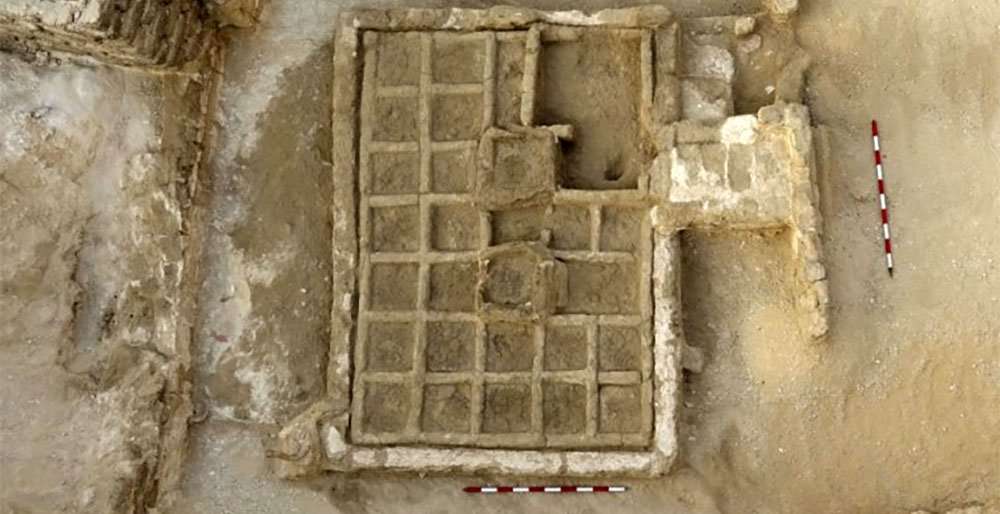Archaeological excavations on the Dra Abu el-Naga hill in Luxor, Egypt, have been ongoing for the past 16 years and are sponsored this year by Indra and Técnicas Reunidas. José Manuel Galán, research professor from the Spanish National Research Council (CSIC) and leader of the Djehuty Project, has discovered a 4,000-year-old funerary garden – the first such garden ever to be found.
The discoveries made by the project shed light on a key period when Thebes (now Luxor), became the capital of the united kingdom of Lower and Upper Egypt for the first time, approximately some 4,000 years ago. Dr. Jose Galán explained that it was known that these gardens possibly existed as they appear in illustrations both on tomb walls as well as at the entrances to tombs. The illustrations depict where Egyptians wanted their funerals to be.
The garden consisted of a rectangular area elevated 50 cm off the ground and divided into 30 cm2 beds. Two trees were planted next to the garden. As this is the first time that a physical garden has been found, it is the first time that archaeologists can confirm what they had gathered from iconography. The discovery and analysis of the garden will provide valuable information about both the environmental conditions and the botany of ancient Luxor 4,000 years ago.
Galán added that they believe the plants grown in the garden would have had a symbolic meaning and may have played a role in funerary rituals. The garden will therefore also provide information about religious practices and beliefs as well as the society and culture at the time of the Twelfth Dynasty, when Thebes became the capital of the unified kingdom of Lower and Upper Egypt for the first time. It is known that persea, sycamore and palm trees were connected with the dead’s power of resurrection, while plants such as lettuce had meaning associated with fertility and therefore return to life. It now remains to be seen which plants we be identified by analyzing the seeds that have been collected. Galán describes this as a unique and spectacular find that opens up multiple avenues of research.
Digging in a necropolis not only enabled archeologists to discover details about the world of religious beliefs, funerals and funerary practices, but also helps reveal details about society, about daily life and about the physical environment, both animals and plants. The necropolis thus represents the best way to embrace and understand life, as the ancient Egyptians themselves believed.
The funeral garden was discovered in an open courtyard at the entrance of a Middle Kingdom tomb cut from rock. The tomb probably dates from the Twelfth Dynasty, circa 2000 BCE. The garden, measures 2m x 3m, is elevated and divided into a grid arrangement of 30 cm2 beds spread in rows of five or seven beds. Experts believe these small beds probably contained different types of flowers and plants. At the center of the garden, two beds that are raised higher than the others are probably contained small shrubs or trees.
The researchers recovered a still upright tamarisk shrub in one corner, complete with its 30cm-long trunk and roots. A bowl containing dates and other fruit was found next to this tree. These may have been given as an offering. For the time being, the garden is related to the facade of the tomb. A small mud-brick chapel (46cm high x 70cm wide x 55cm deep) was attached to the façade. In its interior, three stelae, or stone tombstones, were also uncovered.
The stelae are dated to the Thirteenth Dynasty, around the year 1800 BCE – later than the garden and the tomb. One of them belongs to the soldier Khememi, the son of the lady of the house, Satidenu and the other to Renef-seneb. On each, reference is made to the funerary gods Sokar, Ptah and Osiris, and Montu, a local god from ancient Thebes.
Galán concluded that these discoveries highlight the significance of the area around the Dra Abu el-Naga hill as a sacred center for a wide range of worship events during the Middle Kingdom. This helps archeologists understand the religious symbolism that this area of the necropolis holds and the high density of tombs in later times.

RaoulDuke209 on May 11st, 2017 at 15:28 UTC »
The entire planet is layers upon layers of risen and fallen civilizations. Only now with technology both allowing us more information to build perspective from but also more time to explore our minds we are finally digging it all up!
Tune in. This isn't even close to how old most of it will be.
crd3635 on May 11st, 2017 at 14:27 UTC »
They keep finding ancient sites buried in Egypt - how many undiscovered temples, chambers, funeral gardens, etc. will they find in the future? Exciting!
Gurney_Halleck_ on May 11st, 2017 at 12:18 UTC »
Were funeral gardens rare in Egypt? I thought that they made funerals and funeral places very luxurious, at least that was my assumption from knowing that the pyramids were the burial places of pharaohs...
Edit: typo